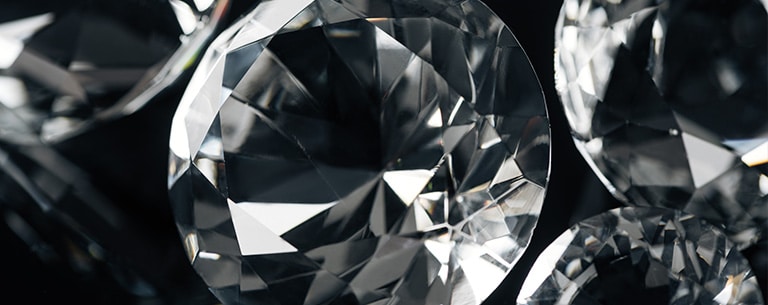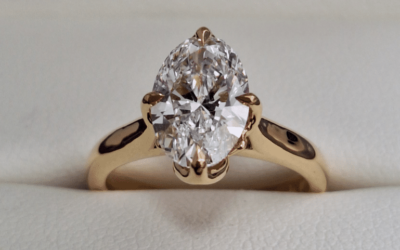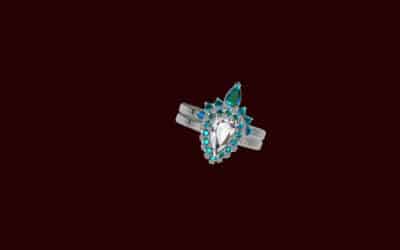All of the materials we use at Burgundy Bespoke are ethically sourced from conflict-free backgrounds, and we pride ourselves in sourcing our diamonds from trusted contacts within the Australian diamond trade. However, if you’d like to know exactly how and where the diamond in your jewellery was made, then a lab grown diamond might be the right choice for you.
If you aren’t familiar with lab diamonds (sometimes referred to as lab-created or synthetic diamonds) or if you have some questions about them or their legitimacy, then this blog should contain everything you need to know.
Are Lab Diamonds Real Diamonds?
They 100% are. The only way a lab-grown diamond differs from a natural diamond is its origin. A lab-created diamond is “grown” inside a lab using cutting-edge technology that replicates the natural diamond growing process. The result is a man-made diamond that is chemically, physically, and optically the same as those grown beneath the Earth’s surface.
Natural diamonds consist of carbon atoms with a few impurities, such as nitrogen, sulphur or uncrystallised carbon, that vary based on the type of diamond. Due to the manufacturing process of lab diamonds, they have the exact same structure and are near impossible to tell apart from natural diamonds. This means you don’t need to worry about the appearance or durability of your lab-grown diamond being sub-par, as they are just as sparkly and strong as a natural diamond.
How are Lab Diamonds Manufactured?
There are two methods used to produce lab diamonds; High Pressure-High Temperature (HPHT) and Chemical Vapour Deposition (CVD). There are three possible manufacturing processes for HPHT diamonds; the belt press, the cubic press, and the split-sphere (BARS) press. All of these processes create the environment of extremely high pressure and temperature that’s required to produce a diamond.
A HPHT diamond begins as a small diamond seed that is placed into carbon, and then the seed is exposed to temperatures of about 1500 degrees Celsius and pressurised to approximately 1.5 million pounds per square inch using one of the aforementioned processes. This causes the pure carbon to melt and starts to form a diamond around the starter seed. It then gets carefully cooled, resulting in a pure carbon diamond.
A CVD diamond is a little different, in that it begins as a thin slice of diamond seed which is often a HPHT produced diamond. The diamond seed is placed in a sealed chamber and heated to around 800 degrees Celsius, and then the chamber is filled with a carbon rich-gas, like Methane, and other gases. The gases are ionised into plasma using technology similar to that of microwaves or lasers. The ionisation breaks the molecular bonds in the gases, and the pure carbon adheres to the diamond seed and slowly crystallises.
How are Lab-Grown Diamonds Certified and Graded?
Since lab diamonds are chemically, physically and optically the same as natural diamonds, they’re graded using the same criteria and processes as natural diamonds. A diamond is evaluated using the 4c’s – cut, clarity, colour, and carat. Read our Ultimate Diamond Guide to learn more about the 4c’s and how they’re measured.
The Benefits of Lab-Grown Diamonds
Cheaper Than Natural Diamonds
The most swaying benefit of lab-grown diamonds for a lot of people is their price. While lab diamonds are not ‘cheap’, they are still more affordable than mined diamonds.
Why is this? Well, the cost of cutting, polishing and inspecting lab diamonds is pretty similar to mined diamonds, but the supply chain is where the difference lies. Mined diamonds have a much longer supply chain, and since they pass through many more hands than a lab-grown diamond, the cost is increased to cover all the extra work that’s required. Lab diamonds skip the time-consuming mining and distribution steps, meaning they can be sold for a lighter price.
A wide variety of cuts and colours
Where coloured, natural diamonds sell for often inflated prices because of their rarity value. Thanks to technology, lab-grown diamonds are available in a wide variety of stunning colours for a fraction of the cost of natural coloured diamonds. As lab-grown diamonds are produced under regulated conditions they are also steady in colour with no impurities.
So Is Lab-Grown or Mined Better?
People will likely start asking this question more and more as the popularity of lab-grown diamonds grows, but there’s no right or wrong answer; it really boils down to the shopper and their personal preferences.
If you like the idea of a diamond that is a natural part of earth’s mysteries, formed before humans even existed, then a natural diamond might be the best choice for you.
If you value knowing exactly how your diamond was produced, then perhaps a lab-grown diamond would suit you more.
At the end of the day, the significance of your ring doesn’t come from its origin or its path, it comes from the love it represents, and that’s what you should base your choice on.





0 Comments